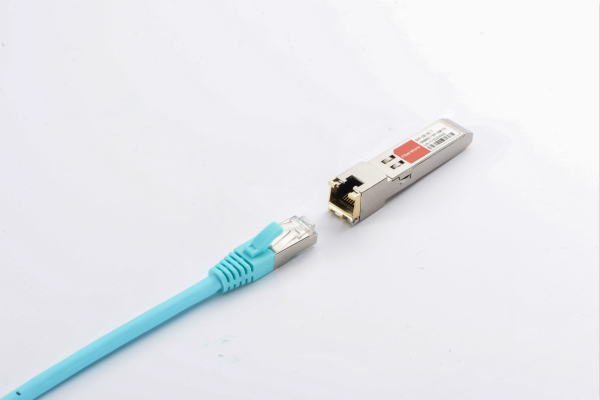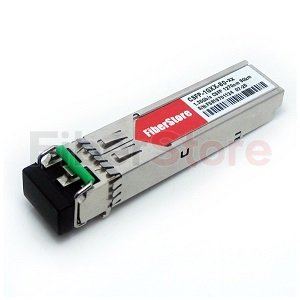Transceiver module is the essential device of a network architecture. As a famous manufacturer of optical products, Cisco published a set of copper SFP transceiver modules to support copper networking. Here focus on Cisco SFP compatibility matrix to present a comprehensive Cisco SFP datasheet for you.
Overview of Cisco Copper SFP Transceiver Module
SFP stands for small form factor pluggable. Copper SFP transceiver is a hot-pluggable transceiver with RJ45 port, so it’s also called SFP RJ45 transceiver. SFP RJ45 transceiver supports 10/100/1000 BASE rate over Cat5 cables. In addition, RJ45 copper transceiver is usually used for transmitting data in a short distance, due to its transmission distance ranging from 10 to 30 metres or from 80 to 100 metres. And Cisco 1G SFP, copper and RJ45 Ethernet cables are much cheaper than the fibre ones, so it’s wise to choose a copper SFP transceiver to make use of the existing cabling system to optimise your network instead of using the fibre cables.
How to Choose A Cisco Copper SFP Transceiver Module
When you decide to buy a copper SFP transceiver, the quality and price matter a lot. But the price between OEM and the third party suppliers varies greatly. If you have plenty of money, you can order one directly from Cisco. If you search for a cost-effective solution, then the third party is a good choice. As for the quality, there are not many differences between Cisco and the third party’s products, because all products must meet the strict standards or MSA (Multisource Agreement). So it’s a wise decision to buy a copper SFP transceiver from a third party. Here I recommend you some copper SFP transceivers from FS.COM, whose transceivers are all tested before shipping.
Figure: Choose a suitable copper SFP transceiver for your network
This GLC-T transceiver is a typical RJ45 transceiver, which is used for Cat5 wiring. The max data rate is 1000Mbps and the max cable distance is 100 metres, which is suitable to connect different switches or routers in a data centre. It’s compatible with most Cisco switches and some FS switches like S5800-48F4S Gigabit SFP switch.
Similar with GLC-T SFP, but this copper transceiver supports 10/100/1000 auto negotiation. And the operating temperature is different. It is an extended temperature range from -5 to 85°C, while GLC-T is from 0 to 70°C. Furthermore, it also operates on standard Cat5 unshielded twisted-pair copper cabling of link lengths up to 100 metres.
Cisco SFP Compatibility Matrix for GLC-T and GLC-TA
Both GLC-T and GLC-TA are supported on a wide range of Cisco equipment. Here lists some of Cisco network switches compatible with GLC-T and GLC-TA Cisco SFP compatibility matrix.
|
Switches Support GLC-T and GLC-TA
|
|
|
Cisco ME-2400-24TS-A
|
Cisco WS-C2940-8TF-S
|
|
Cisco ME-3400G-12CS-A
|
Cisco WS-C2960-24PC-L
|
|
Cisco ME-3400G-2CS-A
|
Cisco WS-C2960-48PST-L
|
|
Cisco ME-3400-24FS-A
|
Cisco WS-C2960G-48TC-L
|
|
Cisco 3750 ME-C3750-24TE-M
|
Cisco WS-C2960S-24TS-S
|
|
Cisco ME-3600X-24FS-M (SFP ports)
|
Cisco 2960S-F48TS-S
|
|
Cisco ME-3800X-24FS-M (client ports)
|
Cisco WS-C2970G-24TS-E
|
|
Cisco 4900 ME-4924-10GE
|
Cisco WS-C2975GS-48PS-L
|
|
Cisco 6500 ME-C6524GS-8S
|
Cisco WS-C3560-24PS
|
|
Cisco 2900 WS-C2948G-GE-TX
|
Cisco WS-C3560G-48TS
|
|
More supportable switches, please check Cisco Transceiver Compatibility Matrix.
|
|
Besides Cisco switches, GLC-T and GLC-TA can also be used on FS.COM S5800-48F4S switch which is a 48 port SFP L2/L3 MPLS switch with 4 10G SFP+ ports. It is a very cost-effective solution for traditional or fully virtualised data centre.
Conclusion
Knowing Cisco SFP compatibility matrix can help us to choose the suitable transceiver and switch quickly. Cisco copper SFP transceiver modules produced by FS.COM can work well with Cisco switches and FS switches. Besides, our Cisco compatible SFPs are the most reliable quality products without high price, and supported by a long time warranty to offer you a great after-sales service. Know more about Cisco copper SFP modules, please visit FS.COM.







